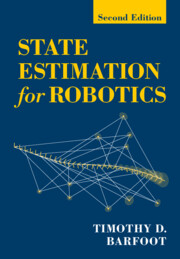Book contents
- Frontmatter
- Contents
- Preface for the First Edition
- Preface for the Second Edition
- Acronyms and Abbreviations
- Notation
- 1 Introduction
- Part I Estimation Machinery
- Part II Three-Dimensional Machinery
- Part III Applications
- 9 Pose Estimation Problems
- 10 Pose-and-Point Estimation Problems
- 11 Continuous-Time Estimation
- Part IV Appendices
- References
- Index
9 - Pose Estimation Problems
from Part III - Applications
Published online by Cambridge University Press: 11 January 2024
- Frontmatter
- Contents
- Preface for the First Edition
- Preface for the Second Edition
- Acronyms and Abbreviations
- Notation
- 1 Introduction
- Part I Estimation Machinery
- Part II Three-Dimensional Machinery
- Part III Applications
- 9 Pose Estimation Problems
- 10 Pose-and-Point Estimation Problems
- 11 Continuous-Time Estimation
- Part IV Appendices
- References
- Index
Summary
With both our estimation and Lie group tools from previous chapters, we now begin to bring the two together. We discuss a classic three-dimensional estimation problem in robotics: pointcloud alignment; this gives us our first example of carrying out optimization over the group of rotations by a few different means. We then present the classic problem of localizing a moving robot using point observations of known three-dimensional landmarks; this involves adapting the extended Kalman filter (EKF) to work with the group of poses. Another common problem in robotics is that of pose-graph optimization, which is easily handled using our Lie group tools. We conclude with a presentation of how to carry out trajectory estimation based on an inertial measurement unit (IMU) both recursively via the EKF and batch using IMU preintegration for efficiency.
Information
- Type
- Chapter
- Information
- State Estimation for RoboticsSecond Edition, pp. 347 - 400Publisher: Cambridge University PressPrint publication year: 2024
